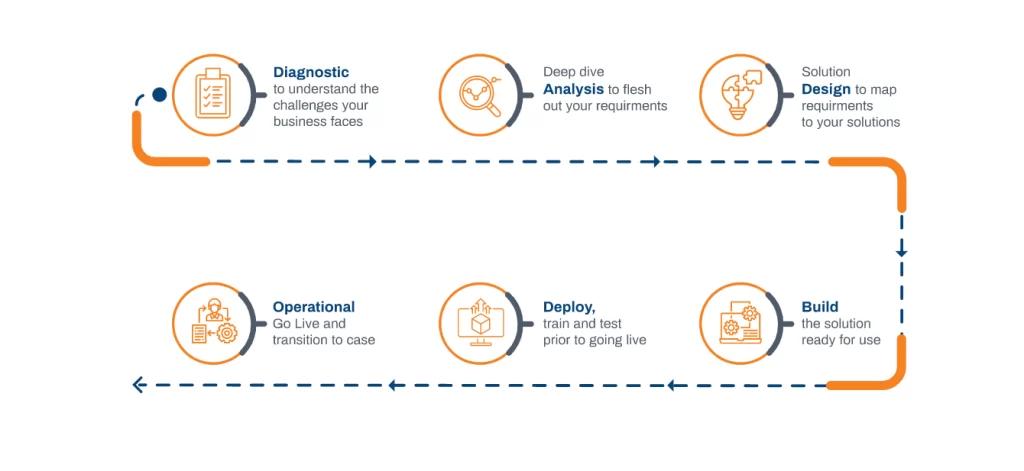Upgrade NAV to D365 BC
- Home
- Upgrade NAV to D365 BC
Leap to Cloud with TECH INTCOG

Any Complexity, Any Size, Any Version
LEAP to breakthrough technologies
Upgrade Factory
Microsoft Accredited ISV Dev Center
Ready For Cloud
Accelerate Digital Transformation
Modern ERP Application interoperable with Microsoft 365 and Azure Services Productivity increase of more than 30% over NAV Last mile integrations using Power Apps Document approval Online approvals make you go paperless
Advanced Cloud Application
AI & ML infused for multiple use cases in the application- Inventory management, Cash flow forecast, Customer Late Payment Predictions.. Power Automate for Robotic Process Automation Advanced analytics through Power BI
Ensure Business Continuity
No Infrastructure Management hassles: Microsoft manages it Security will not be an issue as its taken care of by experts at Microsoft The business remains functional 24x7 Any Device, Any Browser accessible
NAV Out of Mainstream Support
No new Feature releases for NAV No more Regulatory/ Localization Fixes No more Hotfixes No more Cumulative Updates
NAV to BC Upgrade factory
Our mission is to help every NAV customer to migrate to Business Central with minimal Risk and Cost.
Upgrade at Scale
Tech Intcog has invested significant time and effort to define optimal upgrade methodology. To achieve scale and minimize human error we have created tools to detect customizations, conversion of code, data migration, and testing.
Centre of Excellence (COE)
Upgrade is a specialized service managed by a team of experts who have rich experience in code conversion, code refactoring, data migration, and testing.
Upgrade Process

Case Studies
FAQ
Microsoft Dynamics 365 Business Central is a complete ERP from Microsoft for SMB segment. The product is part of the Microsoft Dynamics family, and is the successor product to Microsoft Dynamics NAV. The ERP is available in a SAS and On-Premises model.
Business Central comes with a very impressive Web And Mobile client. Its features and functionalities range from the basic to advanced capabilities in modules – Finance (G&A, Fixed Assets, AR, AP, Bank and Cash, Taxation, Inventory), Sales & Marketing, Purchase, Inventory and Warehouse, Manufacturing, Post Sales Service Management, Jobs and Resources for Project accounting.
Microsoft has planned to release new features in Business Central from April 2020 through September 2020. MS has recently released Business Central Release Wave 1 with improved usability, Better tools for admins and partners, enhanced application features. Microsoft plans to release 2 major updates each year with increased features and capabilities. The latest released version available is BC 2020 Wave 1.
Business Central helps the business to streamline their processes and enable the business to make smarter decisions. It helps in improving forecast accuracy while maintaining compliance and security.
Dynamics 365 Business Central is a direct for SMB organizations and has been able to address the business requirements, preferences and expectations for small and medium-sized businesses in the trading, manufacturing, eCommerce, Services & Projects business domain.
It works well in organizations with as low as 3 users ranging up to 500 users.
Dynamics 365 Business Central On-Premises works in a 3 Tier architecture. There are at least 3 components for Setup: 1. A SQL Db Server which shall hold the Business Central Database 2. An Application Server to set up the Application Services for BC (these could be more than 1 Server depending on the user base and the transactional volume) 3. IIS which is required to host the Web Client for Business Central. The users are supposed to access BC either on a Web Browser (IE, Firefox, Chrome etc.) or else through its universal Tablet/Mobile client.
Financial Management – Finance module provides accounting and finance solutions. With the help of this module, organizations can conveniently manage payables, general ledger, inventory, receivables, fixed assets, cash flow and many more.
Sales & Marketing – In Sales & Marketing, this term is mainly used for successful business growth. Making sales, it consists of telephone calls, one-on-one interaction meetings, etc. for building customer relationship.
Service Management – In which organizations handle profitable decisions such as quickly responds to service requests, response times, schedules, pricing and customer preferences. It manages all aspects of service orders.
Supply chain management – It manages the flow of goods and services. It shows the comprehensive process of goods from manufacturers to wholesaler to the consumer.










